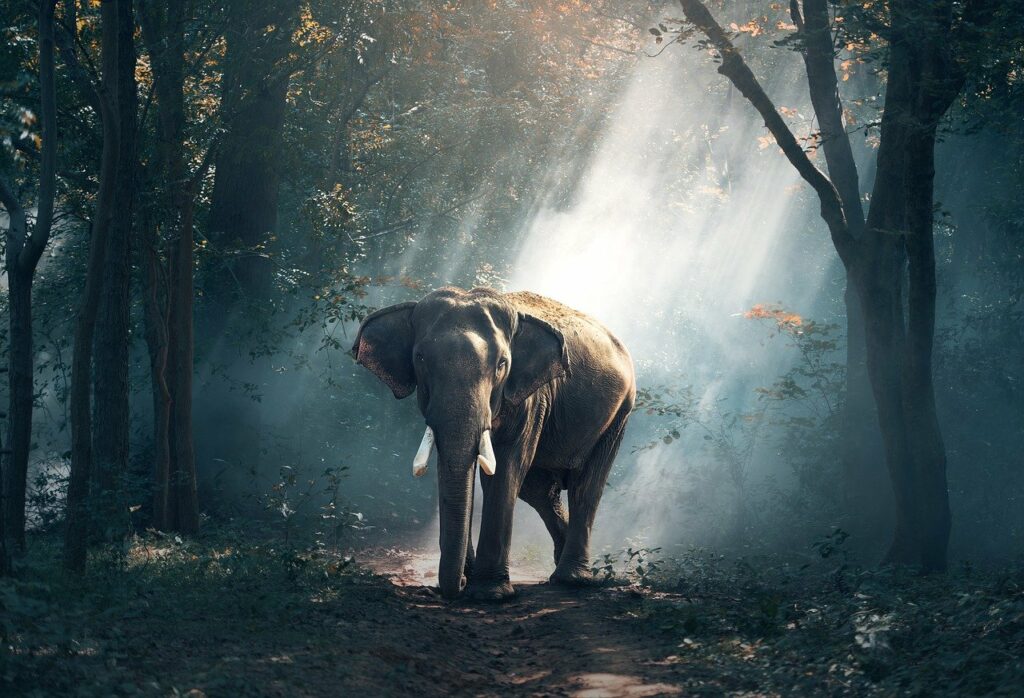Why are elephant populations continuing to decline worldwide? What is our partner organisation in Namibia doing about this? And how can you yourself contribute to elephant conservation? You can find out all this here.
The elephant is the largest land mammal in the world. Zoologists today distinguish between three species that are native to very different parts of the world. The African elephant only occurs south of the Sahara in southern, eastern and parts of central Africa. The smaller forest elephant still lives today in the rainforests of Central and West Africa. The Asian elephant lives in India, Sri Lanka and on some Sudan islands. It can be recognized by its much smaller ears.

Giants at risk
But why is the imposing grey giant, despite the fact that it has hardly any natural enemies, one of the endangered species? Although it happens that big cats of prey kill a young or injured elephant, it is humans who pose the greatest threat to the pachyderms. Although the trade in ivory has been banned in most countries since the 1989 Washington Convention on International Trade in Ivory, poachers continue to hunt elephants mercilessly.
Each year, they kill about eight per cent of African elephants. They sell the ivory of the elephants and then use it to make jewellery or religious objects. In addition, elephants have a slow reproduction rate. Elephant cows carry their calves for a total of 22 months. This is one of the longest pregnancies in the entire animal kingdom. The number of poached animals has been above the natural reproduction rate for years, so the size of the global elephant population is steadily decreasing. In addition, the elephants‘ habitat is also shrinking because it is being destroyed and colonised by humans.
The situation of elephants in the Ugab and Huab River areas of Namibia
What is the situation of the African elephant in Namibia? The African elephant can still be found today in the north of Namibia, among other places. According to the latest report of a Namibian non-profit organisation, there are currently only 61 elephants left in the Ugab and Huab River areas. The majority of them are young animals. Since 2016 the elephant population in these areas has decreased by 32%. Reasons for this are human behaviour, but also lack of resources in nature. Read more about Elephants here: https://edition.cnn.com/2019/06/17/africa/africa-elephants-poaching-niassa-trnd/index.html
Some of the newborn elephant calves have died in the years 2015-2018 for reasons as yet unexplained. In addition, there is a lack of older or higher ranking bull elephants. On the one hand, their experience ensures the survival of the entire herd. On the other hand, they control their younger conspecifics during the „musth“ – the phase of aggressiveness that occurs about once a year and is triggered by a testosterone surge in male elephants from „puberty“. During this „aggressive“ phase, it can happen from time to time that young bull elephants attack other animals or conspecifics. They also destroy fields, watering places for livestock and wells of the local population. Out of anger and desperation, many farmers reach for their guns.
Our partner organisation in Namibia
This is where our partner organisation in Namibia comes in with the elephant protection project. It strives for a peaceful coexistence of elephants and humans. Even simple preventative measures such as building walls around wells and water tanks for the local people as well as freely accessible water basins for the elephants defuse the difficult situation.
An important step is the staking out of large areas of land as so-called wildlife corridors. These enable the animals to move unhindered from one national park to another and across national borders. Since this land is being lost to the farmers as potential grazing or cropland, it is also necessary to promote the understanding of the local population for the behaviour and needs of elephants in educational programmes.